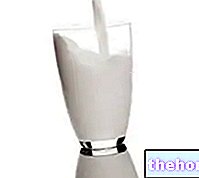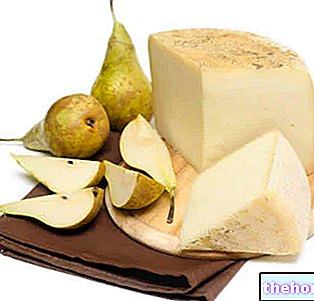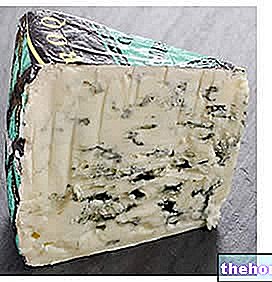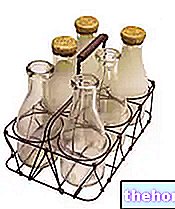Generality
Scamorza (or provola) is a typical Italian dairy product; the appearance is similar to that of caciocavallo.

The table below summarizes the local terms used to identify this cheese.
NB. In the countries of Eastern Europe there are some similar products such as Parenica.
Scamorza is a stretched curd cheese made from cow's milk or, alternatively, from buffalo and more rarely from sheep.
In addition to the normal type, smoked and stuffed variants are produced.
The simple scamorza has a sweet, delicate taste and a compact and fibrous appearance.
The organoleptic and gustatory characteristics of scamorza are typical of a curd enriched with acidifying lactic ferments.
Scamorza belongs to the II fundamental group of foods: “Milk and Derivatives”. It is a relevant source of: high biological value proteins, calcium, phosphorus, vitamin B2, saturated fat and cholesterol.
Product Description
Scamorza is a short-aged stretched curd cheese, mainly produced in an artisanal way.
The first scamorza were produced with buffalo milk, but today the preference is given to that of cow or, more rarely, of sheep or mixed (cow - sheep or cow - goat).
The milk for the scamorza cheese is pasteurized.
The processing is identical to that of pasta filata such as mozzarella but, unlike the latter, the scamorza is subjected to seasoning, even if for a fairly limited period (usually 1-3 weeks). Some "special" scamorza (such as the one flavored with lemon) are destined to a longer maturation (a few months).
The bacterial graft of scamorza cheese is made up of mesophilic or thermophilic lactic ferments.
The preservation of this cheese must be done dry, in cool and ventilated environments. In the absence of a cellar, it is advisable to place the product in the lower part of the refrigerator, wrapped in a cloth.
The scamorza has a usually rounded shape with an apical narrowing (where it is tied). There may be streaks due to tying with raffia (tenacious fiber similar to jute).
On the surface there is a smooth and glossy film of white or straw color.
When cut, the provolone does not drain whey. The paste is white, compact and fibrous. The flavor is sweet, but more intense than mozzarella.
Smoked types are also produced; in this case, the outer film takes on a burnt brown color. At an industrial level (especially in Lombardy) this process takes place by adding a food additive.
Sometimes an additional ingredient is inserted inside the form, for example the fruit of a citrus fruit (which releases aroma and taste in proportion to the seasoning).
From the health point of view, the scamorza does not show particular problems if it is obtained in good hygienic conditions.
Nutritional Characteristics

Scamorza is a complete cheese, with an important fat content but slightly lower than the category (from whole milk).
Scamorza has a significant caloric intake, deriving above all from lipids, followed by peptides and finally by carbohydrates (not abundant thanks to the lactic fermentation of bacteria).
Fatty acids are predominantly saturated, proteins of high biological value and simple carbohydrates (lactose).
Scamorza brings cholesterol in significant quantities; it does not contain fibers.
Among the vitamins, the levels of riboflavin (vitamin B2) and vitamin A (equivalent retinol) are highlighted.
With regard to mineral salts, the levels of calcium, phosphorus and zinc are appreciable. Sodium is also quite high.
Provola is a food unsuitable for the diet against overweight, hypercholesterolemia, hypertension and, in general, against the metabolic syndrome.
This is due to the abundance of calories, saturated fat, cholesterol and sodium.
Although limited, the concentration of lactose can create some gastrointestinal discomfort for the most sensitive intolerant subjects.
The scamorza does not contain gluten.
Due to the abundance of calcium and phosphorus, this cheese can be frequently used in the diet of growing subjects and those at risk of osteoporosis. It contributes to covering the increased need for minerals necessary for the skeleton.
It does not lend itself to the vegan and raw food diet. Furthermore, if obtained with animal rennet (lamb or kid), provolone is to be excluded from the vegetarian lacto-ovo diet.
Provola can be considered a kosher and halal food; it is not admitted by Hinduism.
The average portion of smoked cheese used as a second course is approximately 50 g (170 kcal).
Gastronomic Aspects
In the kitchen, scamorza is used alone as a main course or as an ingredient for more elaborate recipes (appetizers, sauce or condiment for first courses, pizza filling, single dishes, etc.).
Scamorza is a table cheese that is typically eaten fresh or at room temperature, but is also suitable for cooking. In particular, the smoked cheese is subjected to intense heat sources such as: grilled, grilled and skewered.
The wines that best accompany this cheese are reds, preferably locally sourced such as Cerasuolo d "Abruzzo, Falerno, Nero d" Avola young, etc.
For further information: Recipes with Scamorza »
Bibliography:
- Atlas of Cheeses - Giorgio Ottogalli - Hoepli - page 228: 230.
Milk, Dairy Products and Cheeses Asiago Brie Burrata Caciocavallo Rennet Camembert Cheddar Milk Cream Crescenza Emmental Feta Milk Flakes Fontina Herbal Cheeses Lean Cheeses Cheeses rich in calcium Gorgonzola Gouda Grana Padano Gruyere Kéfalair Adapted milk Artificial milk Condensed milk Asphyxiated milk Goat's milk Sheep's milk Rice milk Soy milk Powdered milk and concentrated milk Skimmed and semi-skimmed milk Lactose-free milk Milk Vegetable milk Dairy products Lerdammer Mascarpone Montasio Buffalo mozzarella Mozzarella Whipped cream Cooking cream Fresh cream Parmigiano Reggiano Pecorino Philadelphia Primo Sale Provolone Ricotta Robiola Roquefort Scamorza Sottilette Squacquerone Taleggio Tomino Yogurt OTHER ARTICLES MILK AND DERIVATIVES Categories Alcoholic foods Meat Cereals and derivatives Sweeteners Sweets Offal Fruit Dried fruit Milk and derivatives Legumes Oils and fats Fish and fishery products Cold cuts S pezie Vegetables Health recipes Appetizers Bread, Pizza and Brioche First courses Second courses Vegetables and Salads Sweets and Desserts Ice creams and sorbets Syrups, liqueurs and grappa Basic preparations ---- In the kitchen with leftovers Carnival recipes Christmas recipes Light diet recipes Women's Day, Mum, Dad Recipes Functional Recipes International Recipes Easter Recipes Recipes for Celiacs Recipes for Diabetics Recipes for Holidays Recipes for Valentine's Day Recipes for Vegetarians Protein Recipes Regional Recipes Vegan Recipes




























